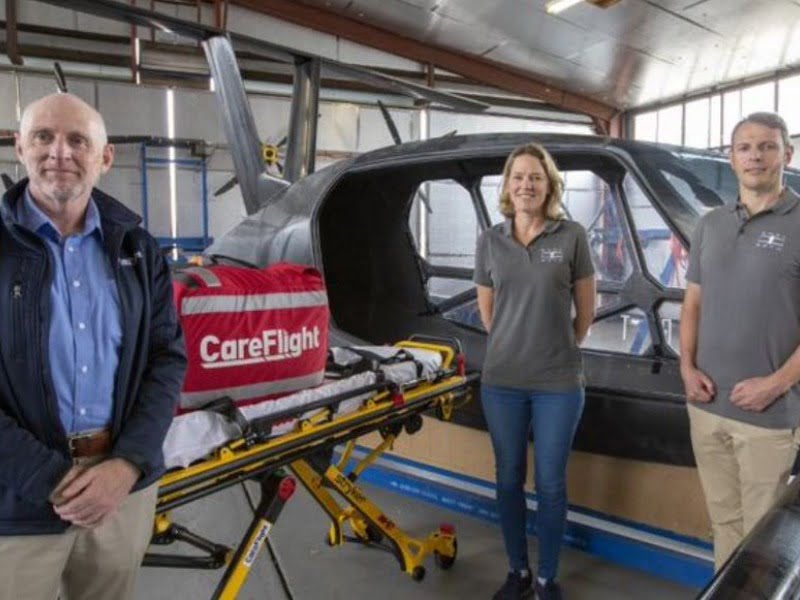A Bankstown Airport-headquartered startup, AMSL Aero, has officially launched its electric air ambulance, the Vertiia.
The vertical takeoff and landing (or VTOL) vehicle — a flying car — is under development through a two-year CRC-P project, supported by a $3 million grant. It is led by AMSL, with partners CareFlight, University of Sydney and Mission Systems.
According to a statement from CareFlight on today’s launch, the zero-emission vehicle’s cruising speed is 300 kilometres per hour and its range 250 kilometres (electric-powered) or 800 kilometres (hydrogen-powered).

Co-founder Andrew Moore said the potential applications were vast, but they have initially targeted the area of greatest current need: providing rapid access to medical services for vulnerable remote, rural, and regional communities.
The Australian invention could “transform patient outcomes in vulnerable regional and remote communities,” according to CareFlight chief executive Mick Frewen.
“Unlike aeromedical planes that require a runway, Vertiia will carry patients directly from any location straight to the hospital, significantly reducing the complexity and time transporting vulnerable patients. It will also be quieter and safer than helicopters, and will eventually cost as little as a car to maintain and run, transforming aeromedical transport into a far more affordable, accessible, safer, and reliable option,” said Mr Moore.
“Australia’s expansive geography and low population density makes this technology especially valuable, with other crucial applications including airlifting people during bushfires, or transporting rural patients for preventative healthcare and testing, instead of waiting until the point of critical illness, injury, or risk of death.”
“Being the most efficient eVTOL in the world, it also creates a tremendous opportunity to provide zero emissions air transport solutions.”
The statement said CareFlight could deploy the vehicles “within a few years” and that these would be piloted by the organisation’s pilots.
Below is a fact sheet provided by the company:
- Vertiia is “the world’s most efficient eVTOL (electric Vertical Take Off and Landing)” aircraft due to the unique combination of its aerodynamic efficient and structural design – it means it travels further using less energy than other eVTOLs in development elsewhere across the globe – Vertiia uses the same or less energy per seat than a high speed train.
- Like a helicopter, and yet with higher levels of safety and a low noise footprint, Vertiia takes off and lands vertically, but flies fast and efficiently like a plane. It can take off from a small landing site, including roof tops, and does not require an airport or runway.
- Vertiia is a unique patented aircraft design, that is powered by eight electric motors with a tilting wing and box wing configuration.
- Vertiia will be powered by 100 per cent electric batteries or alternative range extending technologies, including hydrogen.
- Vertiia produces zero carbon emissions.
- The initial aircraft will be certified for piloted flight, with autonomy systems installed for future remote piloted applications.
- Vertiia will cruise at a speed of 300km /hour and its initial range will be 250km on battery and 800km+ on hydrogen power.
- Vertiia is specifically designed for aeromedical and passenger carrying purposes and will play a key role in its initial operations, connecting regional and rural Australia, in addition to operating as an air ambulance.
- The first Vertiia production line will carry a pilot, medic and patient for aeromedical use, or a pilot and four passengers for commercial transport services.
- Vertiia’s commercial market entry is planned for 2023.
- Vertiia has the capability to connect Australian regional hubs such as Armidale to Coffs Harbour or Dubbo to Sydney and due to the small number of seats it can conduct on-demand (unscheduled) service to reduce excess capacity (empty seats)
- Vertiia has a per seat cost to operate comparable with short-range (domestic) airliners but has the advantage of taking passengers from door to door due to not requiring a runway
- Vertiia is made in Australia by a team of dedicated engineers and commercial professionals. The aircraft leverages the deep expertise we have in Australia in aerospace technical design, engineering and automated manufacturing.
- AMSL Aero was awarded a Cooperative Research Centres – Projects (CRC-P) Grant from the Commonwealth Government, in partnership with research partner, the University of Sydney, autonomy specialists, Mission Systems and aeromedical provider, CareFlight.
- AMSL Aero was awarded an Advanced Manufacturing Growth Centre grant for innovative manufacturing techniques applied to the prototype aircraft, working in partnership with local expert Australian manufacturers.
- AMSL Aero has been supported by a $3 million investment from IP Group. IP Group has committed $200 million to invest in cutting-edge technologies developed at Australia’s leading Group of Eight Universities. The managing director of IP Group Australia, Dr Michael Molinari, said: “We are committed to investing in world-class, breakthrough technologies like Vertiia. It is yet another example of how innovative technology developed within Australian universities can deliver profound economic and social benefits not just for Australia but globally.”
This article was first published in @AuManufacturing.
Do you know more? Contact James Riley via Email.
